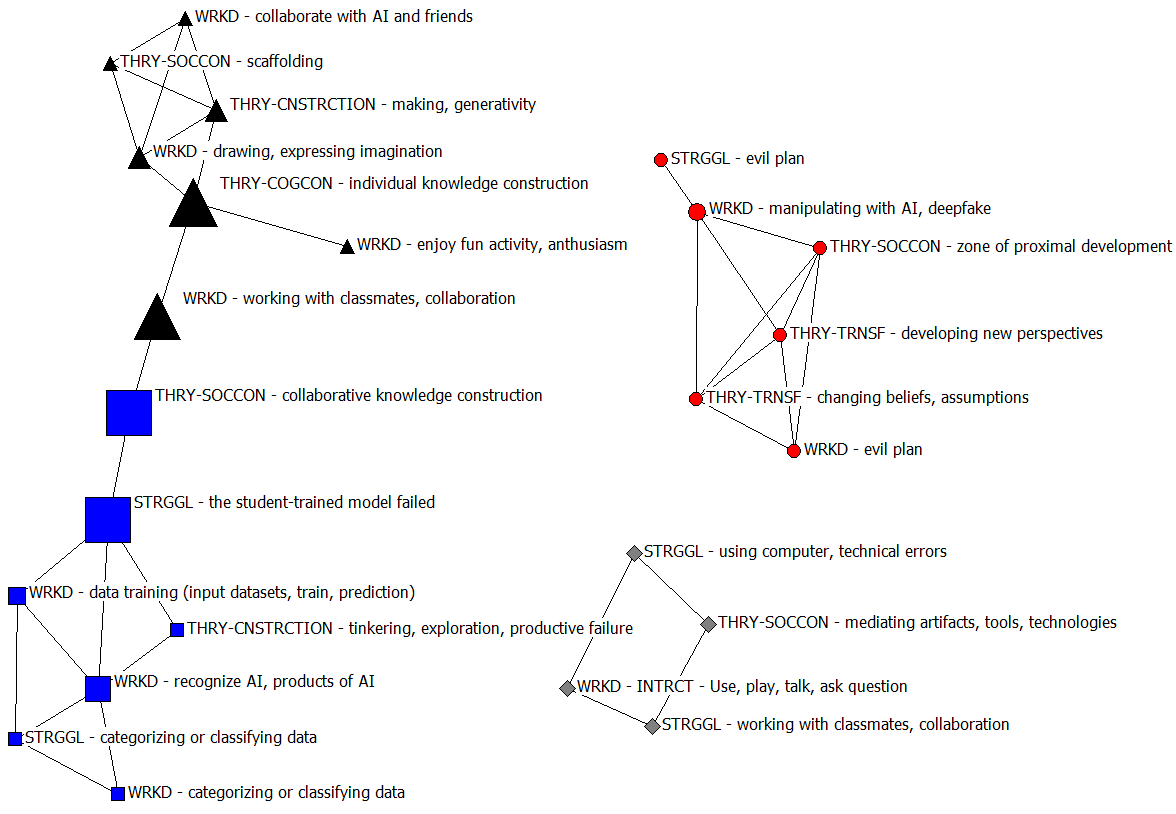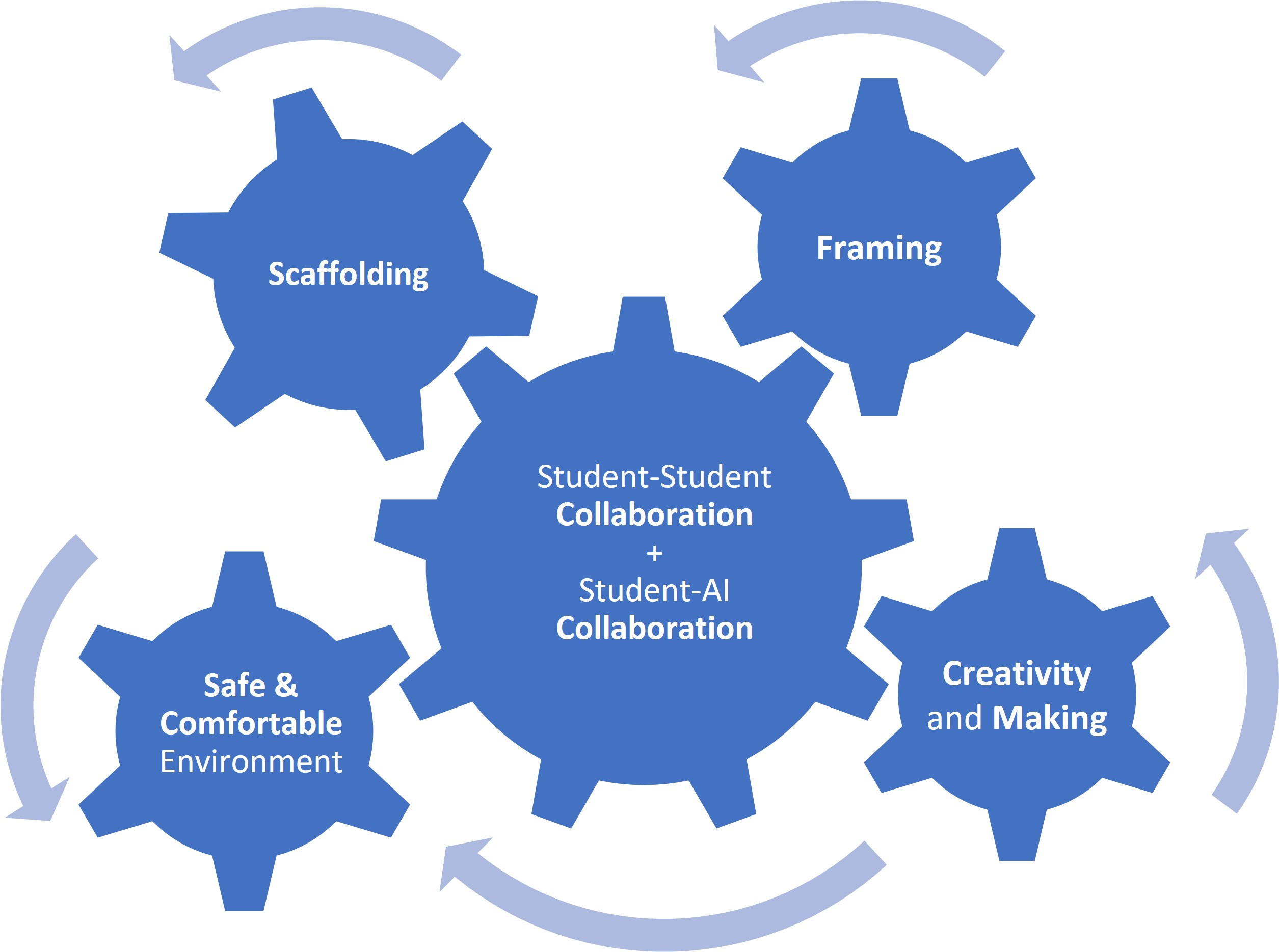The advancement of generative AI technologies underscores the need for AI literacy, particularly in elementary Science, Technology, Engineering, Art, and Mathematics (STEAM) education.
- AI literacy
- generative AI
- STEAM education
- elementary school
1. Need for AI Literacy in Elementary Education
Artificial Intelligence (AI) is becoming an important part of everyday life where its applications range from healthcare to education. As technology becomes more accessible, children are also becoming familiar with AI through voice assistants like Google Assistant, Siri, Alexa and educational apps. Research studies are exploring ways AI can enhance learning in subjects like science, technology, engineering, and art (STEAM). However, the ethical implications of using AI cannot be ignored. It's vital to teach children not just how to use AI, but also to understand its ethical and societal impacts. This is what is meant by AI literacy, which is emerging as an important part of the school curriculum.
This research [1] specifically focuses on enhancing AI literacy among fifth-grade students in Indonesia. It employs a design-based approach grounded in various learning theories such as cognitive constructivism [2], social constructivism [3], constructionism [4], and transformative learning [5]. Through this approach, the study aims to answer how students experience and engage with AI education, and how well they can articulate the ethical considerations of using AI. The study draws its findings from student reflections and uses them to create design principles for an effective AI literacy curriculum. The aim is to integrate AI literacy into elementary education in a way that is both educational and ethically responsible.
2. Defining AI literacy
Artificial Intelligence (AI) is a field in computer science that aims to create smart machines that can think and act like humans. There are different types of AI: narrow AI, which is designed for specific tasks like facial recognition, and general AI, which could potentially do any cognitive task a human can. Generative AI uses existing data to create new content, finding applications in natural language processing, computer vision, and even the arts [6, 7, 8]. AI literacy, the ability to understand and use AI responsibly, is becoming crucial in STEAM education. This literacy is not just about technical skills but also involves critical thinking and understanding the ethical and social implications of AI [9, 10, 11].
When it comes to educating children about AI, two major models have emerged. Long and Magerko [12] propose that AI literacy includes various competencies such as recognizing AI, understanding its strengths and weaknesses, and ethics. They argue that you don't need to know programming to be AI literate. Touretzky et al. [13] emphasize that K-12 students should have hands-on experiences with AI technologies and should be equipped to think critically about their societal impacts. These models are grounded in different learning theories like constructivism, which focuses on individual and collective knowledge construction, and transformative learning, which involves changing beliefs and assumptions [2-5, 14].
3. Design-Based Research on AI Literacy
The study employs a design-based research (DBR) approach, concentrating mainly on the fourth iteration of a series of learning experiences to improve AI literacy among primary school students. Based on the DBR process as described by Anderson and Shattuck [15], the researchers identified a real-world problem in AI literacy and grounded their solution in cognitive constructivism, social constructivism, constructionist, and transformative learning theories. The study took place in Salatiga, Central Java, involving two public schools with students from predominantly middle-low-income families. The iterative process of the study aimed to refine an intervention that was both supportive and conducive for students to construct knowledge, collaborate, and engage in transformative learning. Data for evaluation came from students' self-reflections on their experiences of the learning activities. Further details about each classroom intervention in each iteration can be read in the journal article of this research [1].
The intervention's effectiveness was evaluated by collecting data on how students interacted with it, what they learned, and their feelings about the experience. The researchers used these insights to make necessary modifications, aligning the design moves with the learning theories originally consulted. The study followed four iterations, each informed by data analysis from the preceding cycle, aiming to continually refine the intervention's effectiveness in supporting student learning in AI literacy. The final stage of the DBR was to share findings and the refined intervention with the broader research community, contributing to the knowledge base about AI literacy [14-17].
The study's fourth iteration used a robust method for data collection and analysis to understand student experiences in learning AI literacy. Data was collected through online reflection papers, where students provided insights into what aspects of the learning experience worked well for them, challenges they faced, and new knowledge they developed. A total of 77 reflection papers were collected and analyzed using MAXQDA Analytics Pro software. Qualitative coding resulted in 38 codes covering 1057 coded segments, identifying "struggles" and "what worked" in alignment with principles from cognitive constructivist, social constructivist, constructionist, and transformative learning theories [18].
To understand the relationships among these aspects, the study employed a learning experience network analysis (LENA) approach using Pearson’s 1-tailed tests and UCINET network analysis software [18-20]. This approach helped identify correlations among the codes and map them into a network database. The researchers utilized the Girvan–Newman algorithm to cluster the network, providing insights into the complex relationships between various facets of student learning experiences [20]. The researchers calculated the betweenness centrality of every node to understand the influence of specific learning experiences within the network [21]. A "design moves" table was formulated to represent these relationships and suggest potential solutions that leveraged theory and strengths to address challenges students faced.
4. Network Analysis of Student Learning
The study employed the Girvan–Newman cluster analysis method [20] to identify four unique groups, or clusters, representing different aspects of student learning experiences. A modularity value (Q) of 0.697 indicated very strong community structure within the data. These clusters were visualized and named as the black triangle, blue square, red circle, and grey diamond clusters. Each cluster included nodes representing student struggles, successful practices, and learning theory principles, and the size of each node indicated its relative importance based on betweenness centrality [34, 35].
The analysis was conducted in four main steps to create targeted solutions for each identified student struggle. Initially, each cluster was studied in detail, considering evidence like student quotes. This was followed by examining the relationships between the struggles, successes, and theoretical principles. Based on what worked well and the underlying learning theories, strategies were devised to address struggles. If a cluster had no struggle nodes but was connected to another struggling cluster, its successes and learning theory principles were applied as solutions to the connected cluster's struggles [35].

Figure 1. Girvan–Newman betweenness values with labels for iteration four [1]
The black triangle cluster reflected student success in collaborative AI activities like drawing. It connected to the blue square cluster, so its principles like constructionism were leveraged to address struggles in that cluster. The blue square cluster contained struggles with data issues and AI training as well as successes aligning with constructionism and social constructivism. Design moves based on these theories were added, like think-aloud protocols. The red circle cluster involved ethical struggles but successes with Instagram filters related to social constructivism and transformative learning. Changes like framing the ethics activity through analogy were made. Finally, the grey diamond cluster had technical and collaboration struggles but positives with AI as a mediating tool per social constructivism. Solutions like regrouping students were implemented.
Overall, the study demonstrates that analyzing connections between different elements of the learning experience can reveal alignment with learning theories to improve outcomes. Further details about the full network analysis and results can be found in the original journal article [8].
5. Key Outcomes and Limitations
The study emphasizes the importance of using established learning theories like cognitive constructivism, social constructivism, constructionism, and transformative learning theory to improve students' AI literacy. It found that student-to-student and student-to-AI interactions are vital for enhancing creativity and understanding as shown in the figure. It is consistent with Long and Magerko’s [12] claim that programming skills are not a prerequisite for AI literacy. This aligns with Lee et al. [9] and How and Hung [14], who argue for AI literacy in broader STEAM education. The study also confirms that hands-on experiences with AI technologies are crucial for fostering AI literacy [13]. The following figure shows the AI literacy learning design principles.

Figure 2. AI literacy learning design principles [1]
The learning environment played a significant role in the students' experience, showing that a safe and comfortable setting is essential for optimal learning outcomes. The study made use of scaffolding techniques to help students overcome challenges, supporting their understanding of complex AI topics. Such an environment enables students to express their ideas freely, learn from mistakes, and ask questions without hesitation, in line with various learning theories [2–5].
Despite the contributions, the study acknowledges limitations. For instance, the research focused on a specific student population in Indonesia and relied on qualitative data. The study also didn't include long-term follow-up, limiting its findings to immediate outcomes. However, the research contributes to AI literacy and STEAM education by providing a model that can be applied in various educational contexts. Future research could expand the demographic scope and include long-term studies to assess the sustainability of improvements in AI literacy.
6. Integrating AI Literacy in Elementary STEAM
The study demonstrates that grade 5 students can develop understanding of AI concepts, potentials, uses, and impacts—without the need for programming skills—through student-student and student-AI collaboration. This supports the idea of integrating AI literacy into broader STEAM education, rooted in learning theories like cognitive constructivism and social constructivism. The research provides preliminary design principles for AI literacy in elementary schools and suggests that future research should expand demographic scope and include long-term studies to assess the impact of such educational strategies.
